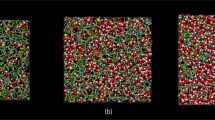Abstract.
In natural as well as industrial processes, water is frequently confined in silica porous materials with pore sizes in the nanometer scale. Understanding the confinement effects on the fluid properties is a fundamental issue, helpful to optimize the industrial processes. The molecular simulation is a powerful tool to study complex polar fluid like water at the atomic scale. The water adsorption/desorption properties in a mesoporous silica glass are investigated by means of Grand Canonical Monte Carlo simulations (GCMC). The SPC and PN TrAZ potential are used to describe water-water and water-silica interactions. The numerical sample of mesoporous silica glass (pore size: 3.6nm) was obtained by off-lattice reconstruction, known to reproduce in a realistic way the geometrical complexity of high specific surface Vycor (pore size distribution, pore interconnections, etc). The intermolecular potential is shown to reproduce the experimental data at 300K (adsorption isotherm and isosteric heat of adsorption). The water structure is analyzed and confinement effects are emphasized. The temperature influence is studied: the hysteresis loop is shown to shrink with an increase in temperature.
Similar content being viewed by others
References
L.D. Gelb, K.E. Gubbins, R. Radhakrishnan, M. Sliwinska-Bartkowiak, Rep. Prog. Phys. 62, 1573-1659 (1999)
S.J. Gregg, K.S.W. Sing, Adsorption, Surface Area and Porosimetry (Academic Press, New York, 1982)
F. Rouquerol, J. Rouquerol, K.S.W. Sing, Adsorption by Powders and Porous Solids (Academic Press, London, 1999)
P. Levitz, Adv. Colloid Interface Sci. 76/77, 71-106 (1998)
P. Levitz, G. Ehret, S.K. Sinha, J.M. Drake, J. Chem. Phys. 95, 6151-6161 (1991)
R.J.-M. Pellenq, B. Rousseau, P. E. Levitz, Phys. Chem. Chem. Phys. 3, 1207-1212 (2001)
S.H. Lee, P.J. Rossky, J. Chem. Phys. 100, 3334-3345 (1994)
E. Spohr, A. Trokhymchuk, D. Henderson, J. Electroanal. Chem. 450, 281-287 (1998)
M. Rovere, M.A. Ricci, D. Vellati, F. Bruni, J. Chem. Phys. 108, 9859-9867 (1998)
C. Hartnig, W. Witschel, E. Spohr, P. Gallo, M.A. Ricci, M. Rovere, J. Mol. Liquids 85, 127-137 (2000)
P. Gallo, M.A. Ricci, M. Rovere, J. Chem. Phys. 116, 342-346 (2002)
H. Landmesser, H. Kosslick, W. Storek, R. Fricke, Solid State Ionics 101-103, 271-277 (1997)
M.J.D. Low, N. Ramasubramanian, J. Phys. Chem. 71, 730-737 (1967)
H.J.C. Berendsen, J.P.M. Postma, W.F. van Gunsteren, J. Hermans, in Intermolecular Forces, edited by B. Pullman (Dordrecht, Reidel, 1981), p. 331
W.L. Jorgensen, J. Chandrasekhar, J.D. Madura, R.W. Impey, M.L. Klein, J. Chem. Phys. 79, 926-935 (1983)
R.J.-M. Pellenq, D. Nicholson, J. Phys. Chem. 98, 13339-13349 (1994)
R.J.-M. Pellenq, D. Nicholson, Mol. Phys. 95, 549-570 (1998)
J. Puibasset, R. J.-M. Pellenq, J. Chem. Phys. 118, 5613-5622 (2003)
J. Puibasset, R.J.-M.Pellenq, J. Chem. Phys. 119, 9226-9232 (2003)
J. Puibasset, R.J.-M. Pellenq, J. Phys.: Condens. Matter. 16, S5329-S5343 (2004)
D. Nicholson, N.G. Parsonage, Computer Simulation and the Statistical Mechanics of Adsorption (Academic Press, London, 1982)
J. Puibasset, R.J.-M. Pellenq, J. Chem. Phys. 122, 094704 (2005)
T. Takei, A. Yamazaki, T. Watanabe, M. Chikazawa, J. Colloid Interface Sci. 188, 409-414 (1997)
N. Markova, E. Sparr, L.Wadsö, Thermochim. Acta 374, 93-104 (2001)
D. Frenkel, B. Smit, Understanding Molecular Simulation (Academic Press, London, 1996)
T. Takei, K. Musaka, M. Kofuji, M. Fuji, T. Watanabe, M. Chikazawa, T. Kanazawa, Colloid Polymer Sci. 278, 475-480 (2000)
C.G.V. Burgess, D.H. Everett, S. Nuttall, Pure Appl. Chem. 61, 1845-1852 (1989)
J.R. Errington, A.Z. Panagiotopoulos, J. Phys. Chem. B 102 7470-7475 (1998)
J. Vorholz, V.I. Harismiadis, B. Rumpf, A.Z. Panagiotopoulos, G. Maurer, Fluid Phase Equilib. 170, 203-234 (2000)
Author information
Authors and Affiliations
Rights and permissions
About this article
Cite this article
Puibasset, J., Pellenq, RM. Water confined in mesoporous silica glasses: Influence of temperature on adsorption/desorption hysteresis loop and fluid structure. Eur. Phys. J. Spec. Top. 141, 41–44 (2007). https://doi.org/10.1140/epjst/e2007-00013-3
Issue Date:
DOI: https://doi.org/10.1140/epjst/e2007-00013-3




